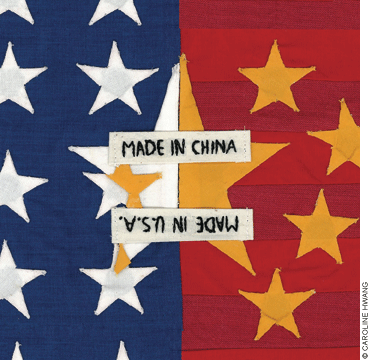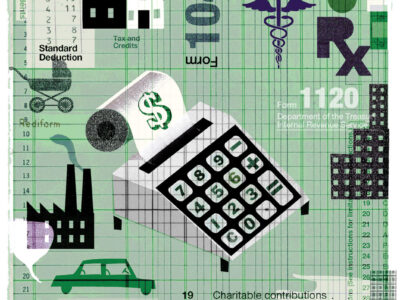
Why the US trade deficit with China is not what it seems.
By Zheng Mingxun | When I first set foot in America in 1954, the nation was in the middle of a decade of postwar transition. William Levitt had just pioneered the modern subdivision with his Long Island development known as Levittown. The first enclosed shopping mall—Southdale Center, in a suburb outside Minneapolis—opened in 1956. The suburban development trend also benefited the automobile industry as cars became necessities for everyone. In less than a decade, half of all American households owned a TV set.
That was more or less the beginning of “Made in America” or “Made in U.S.A.,” a label that represented not only quality but also prestige. Products ranging from clothing to shoes to household products and cars were in demand around the world.
Fast-forward 50 years. Today, whenever I visit my grandchildren in California, one of the highlights is our trip to retailing giant Target to buy toys. I limit them to picking out two items each within a certain budget, which means they spend many agonizing minutes trying to decide what to buy. This coincidentally allows me the opportunity to check out products on nearby shelves.
With my background in consumer marketing, I always enjoy looking at new products. I am always amazed at how many of the products carry a “Made in China” label. Although Americans sometimes equate “Made in China” with cheap, junky goods, the West relies on China for a lot of products that are not poorly made. In fact, Chinese exports form the basis of contemporary consumer culture: computers, smart phones, wall-sized flat-screen TVs, cameras, camcorders, GPS systems, portable e-book readers, and other modern essentials.
These outings often remind me of A Year Without Made in China: One Family’s True-Life Adventure in the Global Economy, a book by Sara Bongiorni. After yet another Christmas awash in plastic toys and electronic gear, Bongiorni decided to live for one year without buying any products made in China. What she found out was that while living without “Made in China” is possible, it is a lot of trouble: inconvenient, if not unrealistic, and likely to cut into a family’s budget.
But why would a Westerner want to boycott Chinese products? Almost certainly because of a commonly held misconception: the idea that China’s actions result in lost jobs in America. And this is patently untrue.
Blaming China for manufacturing woes in America simply does not make sense. The United States remains the world’s leading manufacturer by value of goods produced. In large part, this is because American corporations have shifted toward higher-end manufacturing (auto parts, farm machinery, gas turbines for power plants). This is why Chinese officials will say that huge surpluses showing up in trade statistics overstate their country’s prosperity. While these statistics look good on paper, in fact it is the foreign companies—including many American ones—that reap the largest profits.
In a New York Times article published early in 2006, Dong Tao, an economist at UBS in Hong Kong, was quoted as saying: “In a globalized world, bilateral trade figures are irrelevant. The trade balance between the US and China is as irrelevant as the trade balance between New York and Minnesota.”
There is an underappreciated reason for this. Back when I came to the United States, products that read “Made in U.S.A.” were truly made in America, from extraction of the raw materials through production and assembly to finished product. Today, however, when products carry a “Made in China” label, they are really just “Assembled in China”—a critically important distinction.
With globalization, companies buy raw materials wherever they can get the best price. That means most products are manufactured with materials from around the world, assembled in China, and then shipped to their ultimate markets in the West. So America’s trade deficit is with many countries around the world, not just China.
For example, consider a product that sells for $100 in the United States. I would calculate that no more than 10 percent, and often much less, of that would be likely to stay in China, representing labor for assembling the product, while perhaps another 10 percent would represent materials imported from various parts of the world. So about 80 percent of the retail cost of the product goes to the brand owner, which will cover distribution costs, advertising and marketing expenses, and other administrative costs in addition to profits.
Now take a specific product: the Apple iPhone. According to a paper published by the Asian Development Bank Institute in December 2010, data on bilateral trade are calculated assuming that the entire value of a traded good is created in the exporting country. If that ever made sense, it certainly does not in a global economy marked by increasingly complex supply chains. The iPhone was invented in America by Apple, an American company. The components are manufactured either inside or outside China by companies from several countries. The only part of the process that is unambiguously “Chinese” is the final assembly—a process the authors estimate contributes only $6.50 to the $178.96 wholesale value of an iPhone.
Yet that entire $178.96 value ends up attributed to China in the calculation of trade statistics. As a result, the iPhone contributed nearly $1.6 billion to China’s bilateral trade surplus with the United States in 2008 and nearly $2 billion in 2009. If the trade data had been based solely on the $6.50, the iPhone would have only added $34 million and $73 million respectively in those years to China’s surplus. Just imagine when this type of situation is applied to all products being assembled in China and exported to the United States.
Of course, as the global supply chains become more and more complex, it may be impossible to say precisely how much value China really adds. Nevertheless, the point is that the reported US trade imbalance with China is definitely overblown and misleading. American lawmakers should consider this in making policy decisions.
China tends to be merely the final stop in many a multinational’s vast global production network. The most inexpensive link in this chain takes place in southern China, where workers are typically paid less than a dollar an hour to do the soldering, assembling, and packaging. If they didn’t do it, would it create jobs in the United States? Probably not. Most American workers would never accept so low a wage and, in any event, in America that kind of assembly line work is typically done by machines.
Another overlooked detail is that by outsourcing components and hardware from China—matching low-cost Chinese suppliers with foreign companies that need products manufactured—American companies boost their return on capital. After joining the World Trade Organization in 2001, China’s trade barriers dropped, creating opportunities for US banks, insurance companies, and retailers. Also, China’s rising demand for raw materials and commodities drives prices up, which is good news for the bottom lines of American steelmakers, mining firms, lumber companies, and other industrial giants. Not only that, cheap Chinese goods have helped to keep inflation low in the United States, thereby easing at least some of the burden of the recession.
Some Chinese companies are beginning to expand abroad by acquiring companies in the West or setting up their own factories. Of course, these may initially involve higher-value products, but at least it will help create more jobs in America and Europe and help rebalance the overall global picture. Some Japanese auto companies, such as Toyota and Nissan, have already made this move. But even as China becomes more active in the higher technology and innovative sectors, it will maintain its “factory of the world” status for some time to come. It will keep on assembling.
Zheng Mingxun (Paul Cheng) WG’61 is a former chairman of the Hong Kong General Chamber of Commerce and a current board member and advisor to companies in China and Asia. This essay, adapted from On Equal Terms: Redefining China’s relationship with America and the West, copyright 2011 by John Wiley & Sons (ISBN 978-0-470-82886-1), is reprinted with permission of John Wiley & Sons, Singapore.




